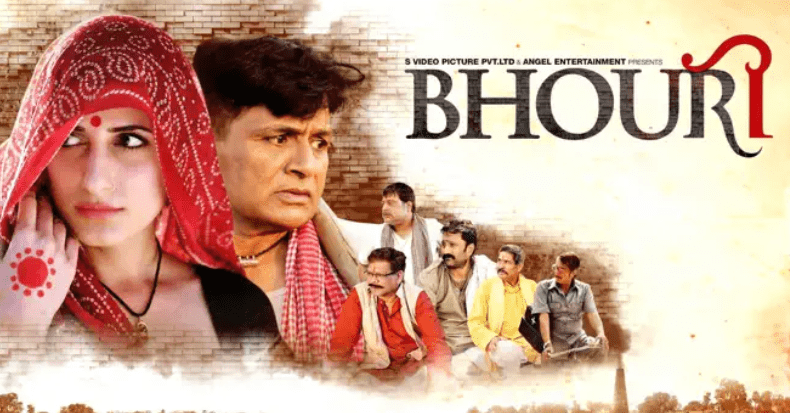“Bhouri” is a poignant drama that navigates the harsh realities of rural India, following the life of Bhouri (Raghuveer Yadav), a young woman ensnared by the oppressive grip of child marriage. As she grapples with the confines of tradition and patriarchal norms, Bhouri’s journey unfolds as a powerful exploration of women’s struggles for empowerment. With a compelling narrative and resonant performances, the film sheds light on pressing issues of gender inequality and societal constraints, prompting viewers to reflect on the challenges faced by women in traditional settings and the imperative for societal change.
Bhouri Movie Watch Online
YouTube
Google Play Movies

Apple iTunes

Exploring Rural Realities and Gender Struggles: A Critical Analysis of “Bhouri”
In the vast tapestry of Indian cinema, where escapism and entertainment often dominate, certain films stand out as brave attempts to delve into the gritty realities of society. “Bhouri,” directed by Jasbir Bhati in 2016, is one such film that dares to tackle the deep-seated issues of rural India while shedding light on the struggles faced by women in a patriarchal society. While the film’s narrative ambition and thematic significance deserve applause, a critical evaluation reveals both its strengths and weaknesses in terms of execution, character development, and emotional resonance.
Narrative and Thematic Exploration:
“Bhouri” opens the door to a world where traditional practices and societal norms dictate the lives of its characters. The film’s exploration of the harrowing practice of child marriage serves as a stark reminder of the regressive practices that still persist in rural areas. Bhouri’s journey, from being a victim of this practice to her quest for emancipation, forms the emotional core of the film. The narrative intent to showcase the indomitable spirit of women in the face of adversity is commendable and resonates with broader social themes.
The film effectively portrays the intricate web of gender inequality and societal expectations, highlighting the challenges women confront in such environments. The juxtaposition of Bhouri’s aspirations against the backdrop of a rigidly traditional society accentuates the enormity of her struggle. The movie does well in exposing the harsh realities of rural life and the complexities that arise from challenging the established norms.
Character Depth and Performances:
Raghuveer Yadav’s portrayal of Bhouri is undoubtedly the film’s strongest asset. Yadav’s nuanced performance captures the quiet determination and resilience of Bhouri, making her journey believable and poignant. The audience becomes emotionally invested in her transformation from a vulnerable victim to a woman who defies societal norms to reclaim her identity.
However, the film falls short in terms of supporting character development. While Bhouri is a well-rounded and multi-dimensional character, the same cannot be said for the secondary characters. Some characters seem one-dimensional, lacking the depth needed to make their actions and motivations truly resonate. This lack of supporting character development weakens the overall impact of the narrative, as it makes it difficult for the audience to fully engage with the broader emotional arc of the story.
Pacing and Narrative Flow:
One of the film’s notable weaknesses lies in its pacing and narrative flow. At times, the pacing feels uneven, with certain sequences feeling stretched while others lack sufficient development. This imbalance disrupts the overall rhythm of the film and can lead to moments of disconnection for the viewer. A more polished narrative structure could have enhanced the emotional engagement and resonance of the film.
Additionally, the film occasionally leans towards melodrama, which dilutes the authenticity of its portrayal of rural life and societal struggles. While melodrama can be an effective narrative tool when used judiciously, its overuse can undermine the film’s credibility and impact. Finding a balance between emotional intensity and subtlety would have served the film’s thematic depth better.
Visual Aesthetics and Setting:
Visually, “Bhouri” captures the essence of rural landscapes and settings with authenticity. The cinematography and production design effectively transport the audience to the village, immersing them in the world of the characters. The film’s attention to detail in capturing the texture of rural life is commendable, as it contributes to the film’s overall realism.
However, while some scenes are visually striking and emotionally resonant, others lack the same finesse. This inconsistency in visual execution can disrupt the film’s immersive quality and prevent the audience from fully investing in the narrative.
Societal Commentary and Impact:
“Bhouri” must be applauded for its courage in addressing significant societal issues. By focusing on child marriage, gender discrimination, and the overarching struggle for women’s empowerment, the film becomes a vehicle for raising awareness and instigating conversations. Its impact is not merely confined to its entertainment value but extends to its potential to provoke thought and inspire change.
In a broader context, “Bhouri” represents the power of cinema to act as a mirror to society. It forces viewers to confront uncomfortable truths and question their own perceptions. While the film has its shortcomings, its social significance and the discussions it can generate cannot be ignored.
Conclusion:
“Bhouri,” with its noble intentions, provides a lens into the deeply entrenched gender struggles and societal constraints prevalent in rural India. The film’s narrative ambition and thematic exploration deserve recognition for addressing vital issues. Raghuveer Yadav’s performance as Bhouri adds emotional depth and resonance to the character’s journey. However, the film falls short in terms of supporting character development, pacing, and occasional melodrama. The visual aesthetics contribute to the film’s realism, though inconsistency is observed. Ultimately, “Bhouri” underscores the potential of cinema as a tool for societal change and reflection, encouraging viewers to engage with uncomfortable truths and contemplate the need for transformation. Despite its flaws, “Bhouri” stands as a testament to the power of storytelling to shed light on pressing societal issues.
By: Priyanka Shah



